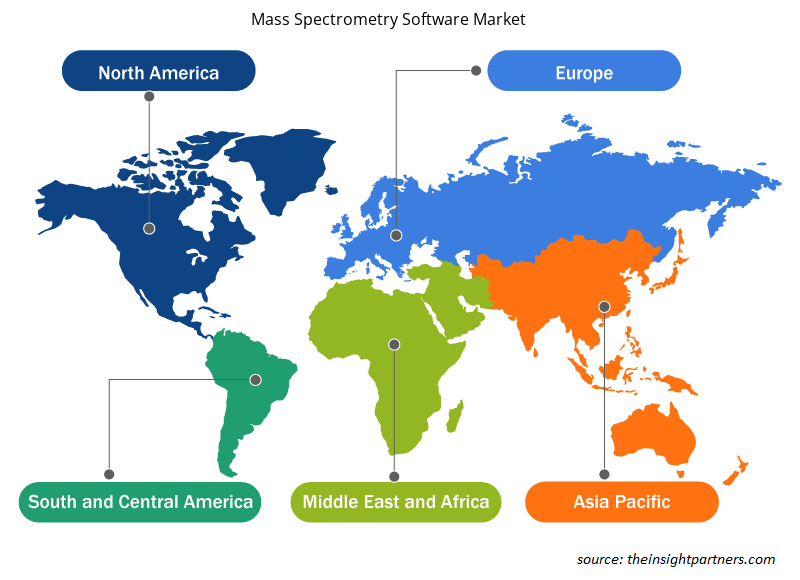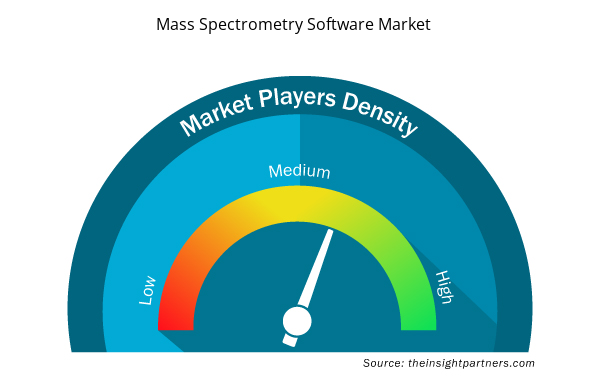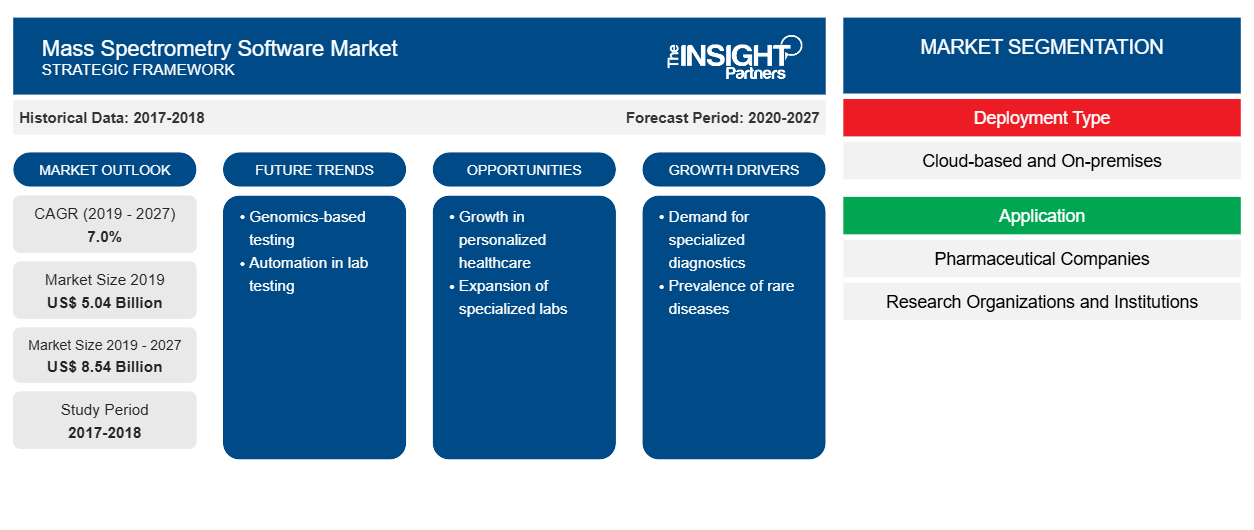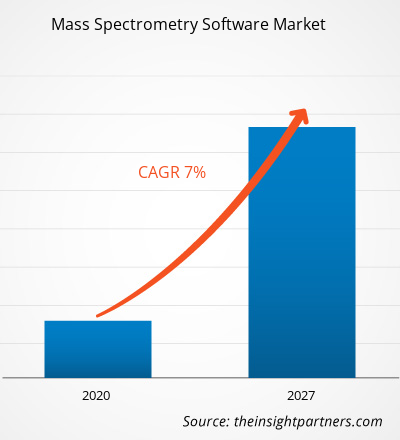Der Markt für Massenspektrometrie-Software wurde im Jahr 2019 auf 5.037,56 Millionen US-Dollar geschätzt und soll bis 2027 einen Wert von 8.541,36 Millionen US-Dollar erreichen; von 2020 bis 2027 dürfte er mit einer durchschnittlichen jährlichen Wachstumsrate von 7,0 % wachsen.
Massenspektrometrie-Software hilft beim Sammeln verschiedener digitaler Instrumente und Werkzeuge, die verschiedene Funktionen und Vorteile für Massenspektrometrieprozesse bieten. Massenspektrometrie-Software hilft bei der Datenanalyse durch spezielle Werkzeuge und hilft, Protein-Biomarker und Proteinabweichungen besser zu identifizieren.
Der Umfang des Marktes für Massenspektrometrie-Software umfasst Bereitstellungstyp, Anwendung und Region. Der Markt für Massenspektrometrie-Software wird basierend auf Regionen wie Nordamerika, Europa, Asien-Pazifik, Naher Osten und Afrika sowie Süd- und Mittelamerika analysiert. Der Bericht bietet Einblicke und eine eingehende Analyse des Marktes für Massenspektrometrie-Software und betont dabei verschiedene Parameter wie Markttrends, technologische Fortschritte, Marktdynamik und Wettbewerbslandschaftsanalyse führender Marktteilnehmer auf der ganzen Welt.
Passen Sie diesen Bericht Ihren Anforderungen an
Sie erhalten kostenlos individuelle Anpassungen an jedem Bericht, einschließlich Teilen dieses Berichts oder einer Analyse auf Länderebene, eines Excel-Datenpakets sowie tolle Angebote und Rabatte für Start-ups und Universitäten.
- Holen Sie sich die wichtigsten Markttrends aus diesem Bericht.Dieses KOSTENLOSE Beispiel umfasst eine Datenanalyse von Markttrends bis hin zu Schätzungen und Prognosen.
Markteinblicke
Zunehmende Anwendungsmöglichkeiten der Genomik und Proteomik
Wachsende technologische Fortschritte haben die genomischen und proteomischen Anwendungen in der Biotechnologiebranche verbessert. Diese Anwendungen sind in hohem Maße von Identifizierungs- und Quantifizierungsergebnissen auf Basis der Massenspektrometrie abhängig. Die Integration von Informationstechnologie in die Biotechnologie hat es ermöglicht, durch schnelles Proteinprofiling automatisch Genomsequenzdatenbanken zu erhalten. Dies bietet Vorteile wie die Echtzeitanalyse kontinuierlich fließender Proteinproben, die für medizinische Anwendungen verwendet werden können.
Die zunehmende Anwendung von Genomik und Proteomik in der Medizinbranche zur Diagnose und Behandlung chronischer Krankheiten hat die Nutzung der Massenspektroskopie erhöht. Die Massenspektrometrie hat die Erfindung therapeutischer Techniken zur Entwicklung personalisierter Behandlungen für Krankheiten wie Krebs, Diabetes und genetische Störungen ermöglicht. Verschiedene Innovationen wurden von Regierungsorganisationen weltweit unterstützt, um die Forschung und Entwicklung in der Biotechnologiebranche zu fördern. So haben beispielsweise das National Cancer Institute und das National Human Genome Research Institute im Jahr 2006 gemeinsam wichtige Initiativen wie den Cancer Genome Atlas zur Entwicklung personalisierter Medikamente für die Onkologie geleitet. Im Rahmen des Programms wurden 2018 etwa 47 Medikamente von der Food and Drug Administration zugelassen, und bis Mitte 2019 waren es fast 20.
Ebenso wurde 2016 das International Cancer Proteogenome Consortium (ICPC) gegründet, um den weltweit führenden Krebs- und Proteogenomik-Forschungszentren eine Plattform zu bieten, auf der sie ihre Forschung im Bereich der Präzisionsmedizin und der damit verbundenen Herausforderungen im Bereich Krebs vorantreiben können. Das ICPC ist in 13 Ländern vertreten und besteht aus 33 Instituten und 11 Mitgliedern des Clinical Proteomic Tumor Analysis Consortium. Die zunehmende Forschung oder Anwendung des Proteogenoms in der Medizinbranche führt zu einer steigenden Nachfrage nach automatisierter Massenspektroskopie. Darüber hinaus wird die Nachfrage nach Massenspektrometrie-Software von verschiedenen akademischen Instituten sowie pharmazeutischen und biopharmazeutischen Unternehmen gesteigert, um ihre Forschungs- und Arzneimittelentwicklungsaktivitäten zu verbessern. Daher wird erwartet, dass die zunehmende Anwendung der Genomik und Proteomik den Markt im Prognosezeitraum antreiben wird.
Einblicke basierend auf Bereitstellungstypen
Basierend auf der Bereitstellungsart ist der Markt für Massenspektrometrie-Software in Cloud-basierte und On-Premise-Software unterteilt. Das Cloud-basierte Segment hatte 2019 den größten Marktanteil. Außerdem wird das Segment im Prognosezeitraum voraussichtlich die höchste durchschnittliche jährliche Wachstumsrate (CAGR) auf dem Markt verzeichnen, da Daten jederzeit und überall leicht zugänglich sind. Darüber hinaus bietet es ein hohes Maß an Sicherheit, Skalierbarkeit, Zugänglichkeit, Erschwinglichkeit, niedrigere Energiekosten und schnelle Bereitstellung. Dies dürfte das Marktwachstum beschleunigen.
Anwendungsbasierte Erkenntnisse
Basierend auf der Anwendung ist der Markt für Massenspektrometrie-Software in Pharmaunternehmen, Forschungsorganisationen und -einrichtungen und andere segmentiert. Das Segment der Pharmaunternehmen hatte 2019 den größten Marktanteil. Es wird geschätzt, dass dasselbe Segment im Prognosezeitraum die höchste durchschnittliche jährliche Wachstumsrate (CAGR) auf dem Markt verzeichnet.
Anorganische Strategien wie Partnerschaften, Fusionen und Übernahmen werden häufig von Unternehmen eingesetzt, um der sich weltweit ändernden Kundennachfrage gerecht zu werden. Dies ermöglicht es den Akteuren auch, ihren Markennamen weltweit aufrechtzuerhalten. Die Marktteilnehmer auf dem Markt für Massenspektrometrie-Software haben auch organische Strategien wie Produkteinführung und -erweiterung eingesetzt, um ihre Präsenz und ihr Produktportfolio weltweit auszuweiten und die wachsende Nachfrage zu befriedigen.
Regionale Einblicke in den Markt für Massenspektrometrie-Software
Die regionalen Trends und Faktoren, die den Markt für Massenspektrometrie-Software im Prognosezeitraum beeinflussen, wurden von den Analysten von Insight Partners ausführlich erläutert. In diesem Abschnitt werden auch Marktsegmente und Geografie für Massenspektrometrie-Software in Nordamerika, Europa, im asiatisch-pazifischen Raum, im Nahen Osten und Afrika sowie in Süd- und Mittelamerika erörtert.

- Erhalten Sie regionale Daten zum Markt für Massenspektrometrie-Software
Umfang des Marktberichts zur Massenspektrometrie-Software
| Berichtsattribut | Details |
|---|---|
| Marktgröße im Jahr 2019 | 5,04 Milliarden US-Dollar |
| Marktgröße bis 2027 | 8,54 Milliarden US-Dollar |
| Globale CAGR (2019 - 2027) | 7,0 % |
| Historische Daten | 2017-2018 |
| Prognosezeitraum | 2020–2027 |
| Abgedeckte Segmente | Nach Bereitstellungstyp
|
| Abgedeckte Regionen und Länder | Nordamerika
|
| Marktführer und wichtige Unternehmensprofile |
|
Marktteilnehmerdichte für Massenspektrometrie-Software: Auswirkungen auf die Geschäftsdynamik verstehen
Der Markt für Massenspektrometrie-Software wächst rasant, angetrieben durch die steigende Nachfrage der Endnutzer aufgrund von Faktoren wie sich entwickelnden Verbraucherpräferenzen, technologischen Fortschritten und einem größeren Bewusstsein für die Vorteile des Produkts. Mit steigender Nachfrage erweitern Unternehmen ihr Angebot, entwickeln Innovationen, um die Bedürfnisse der Verbraucher zu erfüllen, und nutzen neue Trends, was das Marktwachstum weiter ankurbelt.
Die Marktteilnehmerdichte bezieht sich auf die Verteilung von Firmen oder Unternehmen, die in einem bestimmten Markt oder einer bestimmten Branche tätig sind. Sie gibt an, wie viele Wettbewerber (Marktteilnehmer) in einem bestimmten Marktraum im Verhältnis zu seiner Größe oder seinem gesamten Marktwert präsent sind.
Die wichtigsten auf dem Markt für Massenspektrometrie-Software tätigen Unternehmen sind:
- Gewässer. Unternehmen
- Thermo Fisher Scientific Inc.
- Agilent Technologies, Inc.
- Sciex (Danaher Corporation)
- Fortgeschrittene Chemieentwicklung
Haftungsausschluss : Die oben aufgeführten Unternehmen sind nicht in einer bestimmten Reihenfolge aufgeführt.

- Überblick über die wichtigsten Akteure auf dem Markt für Massenspektrometrie-Software
Nach Bereitstellungstyp
- Cloudbasiert
- Vor Ort
Nach Anwendung
- Pharmaunternehmen
- Forschungsorganisationen und -institutionen
- Sonstiges
Von
Geographie
Nordamerika
- UNS
- Kanada
- Mexiko
Europa
- Frankreich
- Deutschland
- Italien
- Vereinigtes Königreich
- Russland
- Restliches Europa
Asien-Pazifik (APAC)
- China
- Indien
- Südkorea
- Japan
- Australien
- Restlicher Asien-Pazifik-Raum
Naher Osten und Afrika (MEA)
- Südafrika
- Saudi-Arabien
- Vereinigte Arabische Emirate
- Rest von MEA
Süd- und Mittelamerika (SCAM)
- Brasilien
- Argentinien
- Rest von SCAM
Firmenprofile
- Wassergesellschaft
- Thermo Fisher Scientific Inc.
- Agilent Technologies, Inc.
- Sciex (Danaher Corporation)
- Fortgeschrittene Chemieentwicklung
- Bruker
- Adaptas-Lösungen
- SpectralWorks Ltd.
- Shimadzu Wissenschaftliche Instrumente
- PerkinElmer, Inc.
- Historische Analyse (2 Jahre), Basisjahr, Prognose (7 Jahre) mit CAGR
- PEST- und SWOT-Analyse
- Marktgröße Wert/Volumen – Global, Regional, Land
- Branche und Wettbewerbsumfeld
- Excel-Datensatz


- Retinal Imaging Devices Market
- Personality Assessment Solution Market
- Flexible Garden Hoses Market
- Data Center Cooling Market
- Micro-Surgical Robot Market
- Airline Ancillary Services Market
- Adaptive Traffic Control System Market
- Precast Concrete Market
- Online Exam Proctoring Market
- Single Pair Ethernet Market

Report Coverage
Revenue forecast, Company Analysis, Industry landscape, Growth factors, and Trends

Segment Covered
This text is related
to segments covered.

Regional Scope
North America, Europe, Asia Pacific, Middle East & Africa, South & Central America

Country Scope
This text is related
to country scope.
Trends and growth analysis reports related to Technology, Media and Telecommunications : READ MORE..
The List of Companies - Mass Spectrometry Software Market
- Waters. Corporation
- Thermo Fisher Scientific Inc.
- Agilent Technologies, Inc.
- Sciex (Danaher Corporation)
- Advanced Chemistry Development
- Bruker
- Adaptas Solutions
- SpectralWorks Ltd.
- Shimadzu Scientific Instruments
- PerkinElmer, Inc.
The Insight Partners performs research in 4 major stages: Data Collection & Secondary Research, Primary Research, Data Analysis and Data Triangulation & Final Review.
- Data Collection and Secondary Research:
As a market research and consulting firm operating from a decade, we have published and advised several client across the globe. First step for any study will start with an assessment of currently available data and insights from existing reports. Further, historical and current market information is collected from Investor Presentations, Annual Reports, SEC Filings, etc., and other information related to company’s performance and market positioning are gathered from Paid Databases (Factiva, Hoovers, and Reuters) and various other publications available in public domain.
Several associations trade associates, technical forums, institutes, societies and organization are accessed to gain technical as well as market related insights through their publications such as research papers, blogs and press releases related to the studies are referred to get cues about the market. Further, white papers, journals, magazines, and other news articles published in last 3 years are scrutinized and analyzed to understand the current market trends.
- Primary Research:
The primarily interview analysis comprise of data obtained from industry participants interview and answers to survey questions gathered by in-house primary team.
For primary research, interviews are conducted with industry experts/CEOs/Marketing Managers/VPs/Subject Matter Experts from both demand and supply side to get a 360-degree view of the market. The primary team conducts several interviews based on the complexity of the markets to understand the various market trends and dynamics which makes research more credible and precise.
A typical research interview fulfils the following functions:
- Provides first-hand information on the market size, market trends, growth trends, competitive landscape, and outlook
- Validates and strengthens in-house secondary research findings
- Develops the analysis team’s expertise and market understanding
Primary research involves email interactions and telephone interviews for each market, category, segment, and sub-segment across geographies. The participants who typically take part in such a process include, but are not limited to:
- Industry participants: VPs, business development managers, market intelligence managers and national sales managers
- Outside experts: Valuation experts, research analysts and key opinion leaders specializing in the electronics and semiconductor industry.
Below is the breakup of our primary respondents by company, designation, and region:

Once we receive the confirmation from primary research sources or primary respondents, we finalize the base year market estimation and forecast the data as per the macroeconomic and microeconomic factors assessed during data collection.
- Data Analysis:
Once data is validated through both secondary as well as primary respondents, we finalize the market estimations by hypothesis formulation and factor analysis at regional and country level.
- Macro-Economic Factor Analysis:
We analyse macroeconomic indicators such the gross domestic product (GDP), increase in the demand for goods and services across industries, technological advancement, regional economic growth, governmental policies, the influence of COVID-19, PEST analysis, and other aspects. This analysis aids in setting benchmarks for various nations/regions and approximating market splits. Additionally, the general trend of the aforementioned components aid in determining the market's development possibilities.
- Country Level Data:
Various factors that are especially aligned to the country are taken into account to determine the market size for a certain area and country, including the presence of vendors, such as headquarters and offices, the country's GDP, demand patterns, and industry growth. To comprehend the market dynamics for the nation, a number of growth variables, inhibitors, application areas, and current market trends are researched. The aforementioned elements aid in determining the country's overall market's growth potential.
- Company Profile:
The “Table of Contents” is formulated by listing and analyzing more than 25 - 30 companies operating in the market ecosystem across geographies. However, we profile only 10 companies as a standard practice in our syndicate reports. These 10 companies comprise leading, emerging, and regional players. Nonetheless, our analysis is not restricted to the 10 listed companies, we also analyze other companies present in the market to develop a holistic view and understand the prevailing trends. The “Company Profiles” section in the report covers key facts, business description, products & services, financial information, SWOT analysis, and key developments. The financial information presented is extracted from the annual reports and official documents of the publicly listed companies. Upon collecting the information for the sections of respective companies, we verify them via various primary sources and then compile the data in respective company profiles. The company level information helps us in deriving the base number as well as in forecasting the market size.
- Developing Base Number:
Aggregation of sales statistics (2020-2022) and macro-economic factor, and other secondary and primary research insights are utilized to arrive at base number and related market shares for 2022. The data gaps are identified in this step and relevant market data is analyzed, collected from paid primary interviews or databases. On finalizing the base year market size, forecasts are developed on the basis of macro-economic, industry and market growth factors and company level analysis.
- Data Triangulation and Final Review:
The market findings and base year market size calculations are validated from supply as well as demand side. Demand side validations are based on macro-economic factor analysis and benchmarks for respective regions and countries. In case of supply side validations, revenues of major companies are estimated (in case not available) based on industry benchmark, approximate number of employees, product portfolio, and primary interviews revenues are gathered. Further revenue from target product/service segment is assessed to avoid overshooting of market statistics. In case of heavy deviations between supply and demand side values, all thes steps are repeated to achieve synchronization.
We follow an iterative model, wherein we share our research findings with Subject Matter Experts (SME’s) and Key Opinion Leaders (KOLs) until consensus view of the market is not formulated – this model negates any drastic deviation in the opinions of experts. Only validated and universally acceptable research findings are quoted in our reports.
We have important check points that we use to validate our research findings – which we call – data triangulation, where we validate the information, we generate from secondary sources with primary interviews and then we re-validate with our internal data bases and Subject matter experts. This comprehensive model enables us to deliver high quality, reliable data in shortest possible time.


 Holen Sie sich ein kostenloses Muster für diesen Bericht
Holen Sie sich ein kostenloses Muster für diesen Bericht